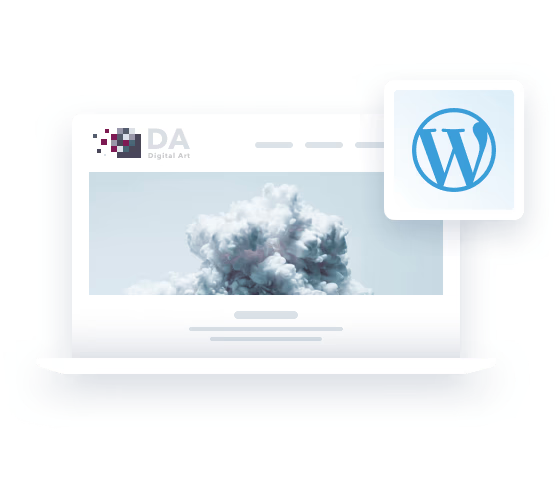Create a blog the easy way
Learn how to choose the right software
Plan your blog with our checklist
Start blogging and share your story


Features you need to create a blog
Easy editing: Blog software is designed so you can publish your content easily. It should have an intuitive editor to help you to format your texts and images, even if you don't have any tech or design experience.
Customizable templates: A blog comes with various design templates, so you focus completely on your content. Just choose the template that suits you — you don’t need any web design knowledge.
Searchability: You'll be writing a lot of posts, so you need to make sure they're well organized. Good blog software will display your posts clearly so you, and your followers can always find them again.
Intuitive navigation: Visitors should be able to find their way around your blogging website easily, otherwise they’ll give up and leave.
Search engine optimization: It's obvious — when you create a blog, you also want people to read it. Make sure you choose a blog platform with integrated SEO so people can find your posts.

How to start a blog
1
Think of a catchy name
2
Get the blog design right
3
Gather content ideas
4
Write your first post
5
Create categories
6
Share your content
Choose your managed WordPress plan
New & improved Now faster, with more features, and customizable managed update settings.
1 website
25 GB of SSD storage
AI website creation
0
AI chatbot
0
Add-on library
0
SEO plugin 0
1 email address
Free domain for 1 year 0
Free SSL 0
SiteAnalytics 0
Automatic updates 0
Vulnerability scanning
0
Now with AI content tools
1 website
50 GB of SSD storage
AI website & content creation
0
AI chatbot
0
Add-on library
0
SEO plugin 0
5 email addresses
Free domain for 1 year 0
Free SSL 0
SiteAnalytics 0
Automatic updates 0
Vulnerability scanning
0
Caching plugin 0
Jetpack Backup 0
1 website
75 GB of SSD storage
AI website & content creation
0
AI chatbot
0
Add-on library
0
SEO plugin 0
10 email addresses
Free domain for 1 year 0
Free SSL 0
SiteAnalytics Plus 0
Automatic updates 0
Vulnerability scanning
0
Caching plugin 0
Jetpack Backup 0
State and local taxes will apply. Click here for our General Terms and Conditions.
Platform technology 0
Storage technology 0
Automatic updates 0
PHP versions 0
Free domain for 1 year 0
Subdomains 0
Wildcard SSL certificates included 0
2 GB email accounts 0
SEO plugin 0
PHP memory limit 0
PHP with OPCache 0
Caching plugin 0
―
HTTP/2 0
gzip 0
RAM 0
Vulnerability scanning 0
Malware protection 0
DDoS protection 0
Georedundant data centers 0
Daily backups 0
Jetpack Backup Daily 0
―
Anti-phishing and anti-spam filters 0
SSH 0
WP-CLI 0
.htaccess 0
Domain API 0
git 0
iPv6 ready 0
Cron jobs 0
SSI 0

Start your own blog
When starting a blog website, remember that your content should deliver value to visitors. So put yourself in the readers’ shoes when you write your posts. Do this when coming up with topic ideas as well as when deciding on the presentation. Break up your blog posts with images, lists, and subheadings so they're easier to read.
Another important aspect when writing a personal blog is that you need to post new content regularly. If you publish a couple of posts per week, readers will want to come back to check out the latest. This is the perfect way to gradually build up readership and gain regular followers.
Yes! A blog can have great added value for a business as long as you cover relevant topics. A successful business blog shows your clients how knowledgeable your company is and helps to gain their trust. It’s also a way to create customer engagement. Ask questions so that readers can get in touch with you either by commenting, by emailing, or by using their own blog. You'll also pick up learnings and SEO-boosting links that can bring in more visitors. A new reader could be your next customer!
Anything! Whether it’s cooking, crafting, baking, or comic books — the important thing is that you are passionate and knowledgeable. In addition, it’s important to find your own style when writing the blog so you stand out from other bloggers and catch readers’ attention. Whatever you do, don’t copy what other bloggers have written or pretend to have an interest in something you don’t. Readers will quickly notice and move on.
As long as you have the ideas, passion, and a basic technical framework, you can make it as a blogger. You don’t have to worry about not having much (or any) technical knowledge since most software options for starting your own blog are beginner-friendly. Building up a following does take time, so you need to be patient. You might only have a few readers at the beginning and then notice your community growing as you share more posts. Being active on social media is also a great way to promote your blog.
Yes, and it’s a really good idea to do so. Your logo is part of your brand and it’s how to get recognized across the web. You don’t even need to hire a graphic designer to create a blog logo if you use the IONOS Favicon Generator. This creates small graphics, which are then displayed in the browser tab. Another helpful IONOS tool is the Logo Maker. You can use it to design a logo for free.